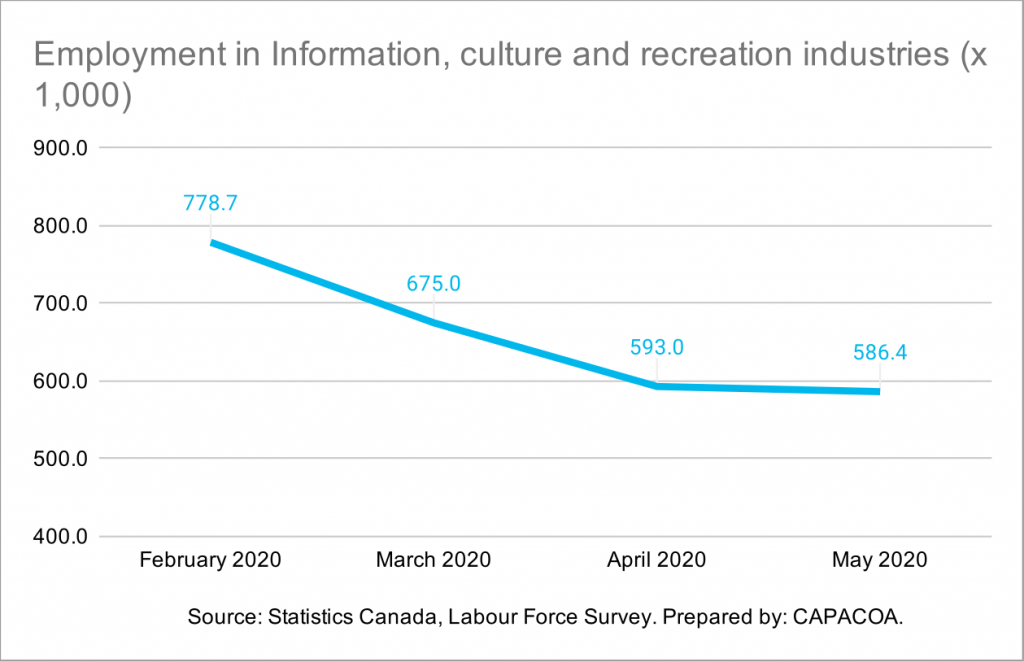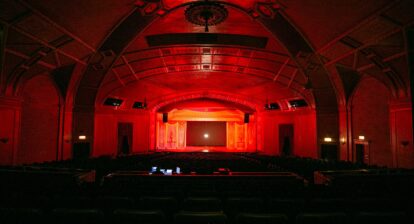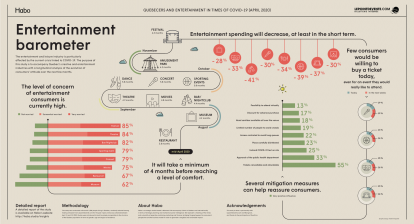Statistics Canada released the Labour Force Survey results for the month of May. After cumulative losses of 3 million jobs since the beginning of the COVID-19 outbreak, employment rose 1.8% in May. However, while most industries saw a rebound, employment continued to decline in the culture sector.
In March and April, the information, culture and recreation industries had seen the largest job loss after the accommodation and food industries. In May, whereas accommodation and food rebounded 6.8%, culture shed another 1.1%.

Between February and May 2020, 192,300 workers in information, culture and recreation industries lost their job. Employment declined from 778,700 to 586,400: a 24.7% drop.
Statistics Canada also released figures on total hours worked, which are useful to track reductions in hour worked for both self-employed and employed workers. Total hours worked increased modestly by 0.6% in May for information, culture and recreation workers. However, since February, the total hours worked decreased 37.1%.
The invisible tragedy of the live performance sector
These statistics fail to depict the unimaginable hardship experienced by performing arts and festival workers.
Statistics for “information, culture and recreation” aggregate series for “arts, entertainment and recreation” (performing arts, spectator sports, agents and managers, independent artists) and “information and cultural industries” (publishing, software, motion picture, broadcasting, telecommunications, etc.). These are much different industries and they were not affected in the same fashion by physical distancing measures. As a matter of fact, the Canadian Survey on Business Conditions revealed that the arts, entertainment and recreation industry was one of the three most severely impacted industries on all survey indicators. The dramatic impact felt by the arts, entertainment and recreation industry is likely ‘averaged up’ by the amalgamation with the information and cultural industries. The live performance domain, which provides a large proportion of “arts, entertainment and recreation” employment, only represented 10% of all culture jobs in 2017 according to the Culture Satellite Account (70,000 of 666,000 culture jobs). But one has to wonder, how many of the “information, culture and recreation” jobs lost in May were in fact live performance jobs.
A disaggregated series just for arts, entertainment and recreation would likely – and sadly – paint an even darker picture in terms of the proportion of lost jobs.
The live performance sector was among the first ones to be closed and will be among the last to reopen. It’s also a sector in which the recovery will be particularly long. Some cultural consumers are reporting they might wait up to 5 months before returning to indoor events after they are allowed to reopen. Will emergency support programs last long enough to help performing artists see the crisis through? Or will they be invisible collateral victims of the COVID pandemic?









Pingback: Support for artists is key to returning to vibrant cultural life post-coronaviruS - Fame Week Africa